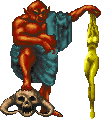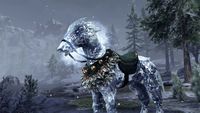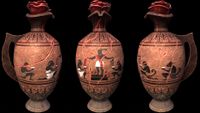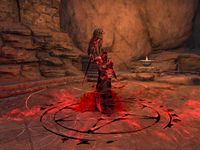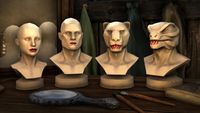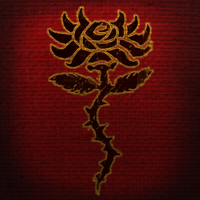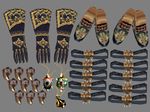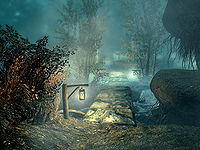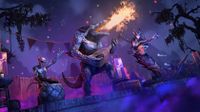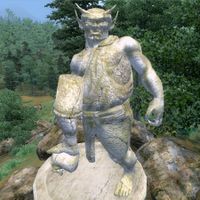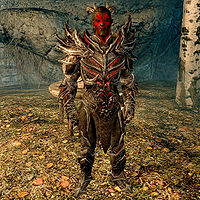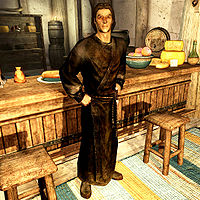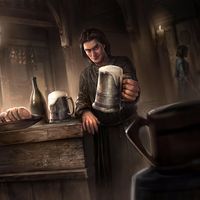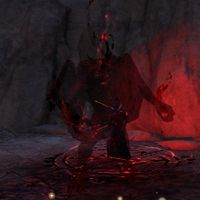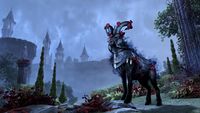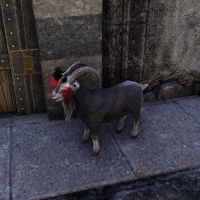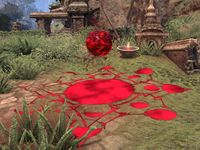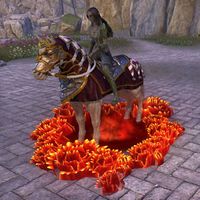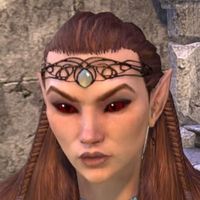Lore:Sanguine
Sanguine, known to his worshippers as the Lord of Revelry,[1]:293 Blood-Made-Pleasure,[2] and he who tastes the Shaven Fruit,[3] is a Daedric Prince whose sphere is hedonistic revelry, debauchery, wild orgies, and passionate indulgences of darker natures.[4][5]:11 As the Daedra Prince of Lust, Perversity, and Unnatural Sexual Relations, anything in excess is his motto.[6] Sanguine is depicted as a portly yet muscular crimson-skinned man with a demonic head with horns, tusks, usually with a bottle in his hand or a whore under his thumb.[7][8] He is thought to control thousands of small realms called the Myriad Realms of Revelry.[9] He is known to be allied with Vaermina,[10] while his enemies are Ebonarm,[10] the House of Dibella[11] and the Benevolence of Mara.[10] His summoning day coincides with Heart's Day, which falls on the 16th of Sun's Dawn.[12] Celebrations associated with Sanguine include the vulgar Crendali Festivals, which he is said to have helped Reman with creating,[UOL 1] and Carnaval.[13]
Sanguine has a reputation among mortals for not being "as bad" as other Daedric Princes and is likelier than most Princes to take an interest in mortal affairs.[14] Some see him as a harmless, inveterate drunk due to his outgoing nature and his propensity for partying and drinking alcohol.[15][16] Despite his vulgar nature, many consider Sanguine one of the more "sophisticated" Princes.[17] He is described by Lyranth to be one of the weaker Princes.[18] Those who worship him or appreciate his nature claim that Sanguine has never hurt anyone maliciously.[19] He enjoys playing pranks on others.[20] He is reputed for throwing the best parties in Oblivion and celebrates at the drop of a hat. One instance of these spontaneous celebrations is the 400th anniversary of Sanguine's dog learning to play "undead," which occurred sometime around 2E 182.[21] All manner of entertainment can be found at Sanguine's parties, such as stage plays, orgies,[5][6] bardic concerts, dancing, skooma,[22] arena fights, and of course, refreshments.[23] Food and drink are usually present, but Malacath is not.[24][UOL 2]
Partying with Sanguine can be a dangerous affair, as those who stay too long may not want to leave or are enticed to stay and may end up dying there.[25] It is in Sanguine's nature to indulge the natures of others, particularly their darker desires—so to Sanguine, 'absolute control' is anathema.[9] The Daedra in attendance may also become violent towards mortal guests.[26] Sanguine welcomes all mortals to his shindigs. Still, those who enter must partake in the drinks there if they wish to remain. Those who drink from Sanguine's goblet will be bound to the party and unable to leave.[27][28] Sanguine's cultists have tricked entertainers into signing contracts that force them to perform endlessly for Sanguine's parties.[29] Some desperate mortals who have been forced to stay have committed suicide to escape.[29] Mortals with businesses or families on Nirn may be tempted to abandon their families and responsibilities to stay forever.[30]
One of his possessions includes a red hat.[31] There exists wine in Sanguine's private stock called 'Sanguine's Reserve' that allows one to control the dead. When poured over a corpse, the spirit of the mortal that the corpse belongs to can be commanded.[25] Scarlet bottles of a rare and expensive 'Sanguine's Rose' perfume are reputed to have aphrodisiacal properties.[32]
Religion and Culture[edit]
Breton[edit]
The Breton holiday of Saturalia has a story where during a winter storm, a lost and abandoned mercenary prayed for rescue, and Sanguine answered it by creating a frozen steed for her, which allowed her to take vengeance against the lord that betrayed her on Saturalia morning.[33] Saturalia was originally a holiday for a "long forgotten god of debauchery", though it is unknown whether this refers to Sanguine or a different deity.[34] However, elements of Saturalia have been adopted by other races and cultures for their New Life Festival thanks to merchants from Wayrest capitalizing on the holiday through consumer goods. Widespread adoption of Saturalia-themed products and practices across Tamriel for usage in the New Life Festival make for a booming market during this time of year, touching even Tamrielans that grew up with their own New Life traditions.[35] Gift giving is something shared among these two holidays.[36][37] Relevant to Sanguine is the youth of the gentry in Elinhir giving each other licentious presents for the New Life Festival that are intended to dare the recipients into lascivious behavior, though the giver's name is never revealed—it's up to each recipient to guess who their 'Secret Sanguine' was.[38]
Imperial[edit]
From under the bed, Lord Sanguine doth peek
To inspire perversions in the wild and meek
Tales of taboos of which virgins blush to speak
The wild rose blooms, perfumes in the burbling creek
The petals, the stem, and the thorns' painful preek
—Mad God's Masque and Bellicose Ball
According to some sources, Sanguine has been a favorite for several Emperors since the foundation of the first Empire. During the reign of Reman Cyrodiil, records indicate Sanguine resided in White-Gold Tower where he is said to have helped Reman with the dubious draftsmanship of the Crendali Festivals. The vulgarities found within these festivals did nothing but hinder Imperial expansion efforts within the Summerset Isles during Reman Cyrodiil's tenure.[UOL 1] In more modern history however, Cyrodilic Daedra worship was conducted only in secret.[39]
In Cyrodiil, those seeking to speak with Sanguine usually offer a bottle of Cyrodiilic Brandy to one of his shrines.[40] It is not difficult to find worshipers of Sanguine during the holiday Carnaval,[13] a portmanteau of carnal and carnival. The early Second Era master vase painter Martina Russus of Cropsford specialized in black figure pottery and created a Colovian relic of Sanguine worship that combines their love of weald wines and Daedric worship into a pitcher depicting kneeling figures accepting a red liquid into their goblets, with the tip adorned with a red rose.[41] Followers of Sanguine have created objects such irregular five-sided ivory dice, where the sigils act as numbers, and small pots of balm made from human blood called "Sanguine Smiles", used at formal occasions.[42]
Khajiit[edit]
Sanguine is known to the Khajiit as "Sangiin": the Blood Cat, the Blood God of the Second Litter,[43] or the God of Death and Secret Murder.[44] According to the writings of Amun-dro, Sangiin is not evil by nature, but his sphere distracts Khajiit from the Path.[43] His sphere encourages people to seek out the urges of blood and pleasure without purpose.[43][45] "Sangiin's Midnight" is the term for when both moons are dark, and bright crimson red claw polish is used during this time.[46] His worship is hidden from the Cat's Eye, Magrus.[44] He is prayed to in secrecy in forbidden shrines.[47] Sangiin grants those born under the sign of The Serpent the gift of swift mending.[48] Wrist sheaths crafted from black leather have prayers to Sangiin written with metallic ink on the inside.[49] The trickster god Rajhin is said to have had a drinking contest with Sanguine.[50] It is alleged that Sangiin was the one who gave Khajiit the secret of wine by spilling the blood of the grapes.[51]
He is said to tempt Khajiit by making their flesh immortal, likely implying he grants a form of vampirism to his followers.[43] Though darker, they are still drawn by his promise of filling their cups and tasting life as Sangiin desires.[52] The vampires of the Hollowfang Clan are devoted followers of Sangiin.[53] Clan members are known to bind their spines in leather and gird their loins, as Sangiin does before a tempestuous night.[54] Hollowfang vampires devoted to Sangiin often perform blood sacrifices. Their thralls may be driven to kill themselves[55] to bring forth a Hemo Helot, an orb of blood used in rituals or to empower other vampires.[56] Hollowfang vampires use Blood Magic to summon blood specters, and may do so while invoking Sangiin's name.[57]
Other[edit]
To the Ayleids, Sanguine was known as the Blood-Made-Pleasure.[2] Those from the kingdoms that worshipped the more malevolent Daedric Princes were known to indulge in the pleasures of art-torture, such as flesh-sculpting and gut-gardening.[58] An ancient Ayleid manuscript attributed to Eldhaal the Inducer describes himself as being overseen and guided by Sanguine in these heinous arts, particularly in the creation of the "Messenger Beast Redeemed".[2]
The Reachmen have no use for Princes such as Sanguine and Clavicus Vile.[17]
Worship[edit]
Sanguine's worshipers drink, dance, wear red lipstick,[59] and make love to honor him.[40][20] According to his Mazken, worshipers must revel in the moment as they've never done and fix on the passionate excess in their minds, then let it go to fully enjoy the next moment, and so on. Some say that with practice, one can see the very debauchery of Sanguine gleaming from their eyes in the form of a vermilion red color.[60] Some worship Sanguine because they think "normal" life is too boring, and they would simply rather be partying than going to work or being with their families.[30][61] During Sanguinary feasts, revelers may wear masks to conceal their identity. Though not usually violent cultists, they are willing to assassinate any uninvited guests who witnessed them partake in such events.[62] Certain extremist cult branches promise the blood of human sacrifices to Sanguine, and go to great lengths to chase down escapees to fulfill their oaths.[63] He inspires perversions in the wild and meek to seek illicit pleasures, such as convincing virgins to take part in taboos.[UOL 3] When the first roses of the season bloom, the followers of Sanguine gather in candlelit gardens to caress each other's faces and mark them with markings described as "a rose-shaped path of pain and pleasure". They use sacred, floral-based inks and their markings are floral in design as a reminder of Sanguine's great gifts: both bliss and agony.[64][65] At his celebrations, shadowy goats called Rams of Dark Delights are fitted with the symbols of the party: sweet drinks and heady rose perfumes, and lead revelers through the streets.
History[edit]
Although the term "sanguine" means a crimson or bloody red liquid,[66] the definition of the word is actually based off Sanguine's name, as the names of Daedra predate the concepts they connote.[67]
First Era[edit]
King Hale the Pious introduced four of the Daedric Princes to the written record almost a thousand years after the publication of the Alessian Doctrines in one of his tractates when he wrote that the wickedness of his political enemies was comparable to the depravity of Sanguine.[68] Sanguine has been a favorite for several Emperors since the foundation of the first Empire. During the reign of Reman Cyrodiil records indicate Sanguine resided in White-Gold Tower where he is said to have helped Reman with the dubious draftsmanship of the Crendali Festivals. The vulgarities found within these festivals did nothing but hinder Imperial expansion efforts within the Summerset Isles during Reman Cyrodiil's tenure.[UOL 1]
Second Era[edit]
Around 2E 53, a growing Sanguine cult began gaining footholds in the Imperial City.[41]
In 2E 582, several Aldmeri Dominion spies entered Sanguine's Demesne and drank from Sanguine's goblet, binding them to the party and rendering them unable to escape.[27] That same year, Sanguine was recognized as a public menace by the authorities in Stormhold, and a bounty was put out for his cultists.[69] Stormhold's citizens knew to stay away from the nearby temple to Sanguine.[70] When the dragon Sahrotnax crashed into Moongrave Fane, the Hollowfang Clan considered it a great boon from Sangiin and performed many rituals in his name to prepare feasting upon the dragon's blood.[71] Sanguine himself manifested in Tamriel for the Jester' Festival, taking on the alias of a Breton named "Samuel Gourone". Seeking to liven up the celebrations for his fellow Prince Sheogorath, he had one of the festival goers compel a group of Daedra to perform as minstrels. Naturally, after the performance, the gathering almost turned into bloodshed before an act of absurd divine intervention turned the Daedra into confetti, presumably banishing them back to where they came.[72]
Third Era[edit]
Just before the events of the Warp in the West, an unknown agent of the Blades was sent by Sanguine to kill a monk who had slain his worshippers. Sanguine promised the Sanguine Rose as a reward, despite the fact that it had been set aside for his favored disciples. The agent accomplished the task, and was given the Rose by a worshipper of the Prince.[73]
Sometime before the Oblivion Crisis, Martin Septim was involved with Sanguine's cult and obtained the Sanguine Rose. An incident in the cult, presumed to have been caused by the dangers of the Rose, left many of his friends dead, and Martin thereafter dedicated himself to Akatosh. The forbidden knowledge on Daedric magic he had gained from the cult, however, was instrumental in bringing about an end to the Crisis.[74] In 3E 433, Sanguine enlisted the Hero of Kvatch to sabotage an excruciating uptight party of Leyawiin Countess Alessia Caro, where she and her guests suddenly found themselves stripped of all their possessions—clothes included, leaving a lasting impression on her otherwise formal public image.[20][75]
Fourth Era[edit]
Circa 4E 176, the Sheathed Blades came across a drunken beggar in the Reach named Otto who claimed to be a Prince. He begged the adventurers to escort him to Riften and he would pay them later. Upon arriving to the city, the Sheathed Blades encountered a group of thugs that knew Otto and attempted to kidnap him. In exchange for the Prince, the thugs were willing to offer a reward. The stories diverge from here, but one account states that the adventurers refused to give up Otto, and due to the display of their loyalty, the beggar revealed himself to be Sanguine. The Daedric Prince stated his wants clearly, he wanted blood and fun, and chose Windhelm as his target. The Sheathed Blades therefore are rumored to have reveled in and ransacked the city, and Sanguine gave his blessing to his wine and blood covered participants.[76]
The apprentice of Balagog gro-Nolob, Urzhag gro-Larak, made camp with some mercenaries near Kynesgrove circa 4E 197. Sanguine came into the camp and introduced himself as a mortal named "Sam" and offered his supplies in exchange for having a place to stay. While the mercenaries helped themselves to Sanguine's seemingly unending supply of alcoholic beverages, Urzhag only took some of his sweet peach treats. Sanguine's "Shaven Fruit" is a recipe Urzhag invented in an attempt to replicate the snack, though he never managed to make it taste as sweet.[77]
In 4E 201, Sanguine, in the guise of a Breton named "Sam Guevenne", challenged the Last Dragonborn to a drinking contest. The events that followed culminated in the Last Dragonborn entering one of the Myriad Realms of Revelry and receiving the Sanguine Rose. This is one of the most recent recorded instances of Sanguine manifesting on Nirn.[78]
Artifacts[edit]
Death Dealer's Fete[edit]
The Death Dealer's Fete is a signet ring associated with the Daedric Prince Sanguine. The ring is cursed, allowing one to hear a glimpse of some revelry in the dead of night, full of laughter and anguished screams. Its enchantment, Escalating Fete, invigorates the wielder during conflicts, increasing higher the longer they are locked into combat. Its intended purpose is believed to be for preventing exhaustion during sex.
It is believed to have been forged in the mid-First Era, and like many rings of that time, has a crude fastening system with heavy handed smithing that makes its silver prongs near unbreakable. The artifact's power comes from the various components that make up the ring's anatomy. The prongs themselves serve as conduits for siphoning magicka. They hold the center stone, an excessively huge and asymmetrical blood-red ruby that is warm to the touch and resonates with great power. The ring's shank is designed for discomfort, as it features minuscule barbs. This design choice is also present within other rings that Sanguine gives to mortals that attend his parties. These rings were enchanted to unexpectedly tighten to prevent exhaustion, though it is unknown if the Fete itself also has this enchantment. The base contains a faded inscription which, when touched, inspires reckless indulgence. The bridge was sculpted to resemble a fanged maw; its open spaces are thought to have once held jewels.
Sanguine Rose[edit]
The Sanguine Rose (sometimes called Sanguine's Rose) is a Daedric artifact created by the Daedric Prince Sanguine. It can take on many forms, including that of an actual rose, a wooden stave carved like a rose or a staff-sized rose. Although powerful, the Rose is not an artifact most would care to possess. It can be used to summon a lesser Daedra, who will attack all except the holder. The Daedra is uncontrollable, unlike those summoned by Conjuration, but as with conjured creatures it is only bound to the mortal plane temporarily. Each time the Rose is used it wilts a little, and when all the petals fall off, it loses its power. When this happens, a new rose blooms somewhere in Oblivion and is plucked by Sanguine to be given to another champion.
Threads of the Webspinner[edit]
The Threads of the Webspinner are 27 pieces of extravagant enchanted clothing and jewelry associated with both Mephala and Sanguine. The story goes that Mephala sought to reward her devoted followers within the Morag Tong, and turned to Sanguine to create them. Each Thread enhances a single skill, such as weapon skills, speechcraft, and magic.
The Myriad Realms of Revelry[edit]
The Myriad Realms of Revelry, also called the Realms of Revelry or Revelry for short, are a congeries of one hundred thousand pocket and sub-realms of Oblivion, created and ruled over by the Daedric Prince of Indulgence, Sanguine. The realms are used mainly as pleasure pockets, refashioned to meet the needs and desires of its visitants. As such, Sanguine exerts minimal control over them, which aligns perfectly with his preferences.
The waters found within the Realms of Revelry were documented in Sanguine's Rites and Realms by the Prisoner of the Evergloam. This text documented a phenomenon in which visions of ill-fated, prince-less realms of Oblivion colliding with each other could be seen within the waters' reflections.
Servants[edit]
Several varieties of Daedra are known to serve Sanguine. Among them are Ogrim, Dremora, Dark Seducers,[79] Banekin and Scamps.[80][81] The Ogrim serve as bouncers at Sanguine's parties.[80] In celebration of the Jester's Festival, Sanguine once forcefully compelled a group of Daedra to form a band for entertainment, consisting of a Daedroth playing the lute, and a Harvester, Scamp, and Winged Twilight playing the flute, bongos, and belly drums.[72]
Sangiin's Thirst is known to manifest as bloody spectres resembling Khajiiti gargoyles.[82] Blood can also be animated in the form of orbs called Hemo Helots or moving coagulant slimes.[56] Hemonculous are blood wraiths that can be summoned by Sangiin cultists.
Gallery[edit]
Notes[edit]
- The Prima Official Game Guide calls Sanguine the "Lord of Hard-Partying".[83]:215
- Sanguine's Black Goat is a goat bred for use in Daedric rituals.[84]
See Also[edit]
- For game-specific information, see the Daggerfall, Oblivion, Skyrim, ESO, and Legends articles.
References[edit]
- ^ The Elder Scrolls V: Skyrim: Prima Official Game Guide — David Hodgson
- ^ a b c Masterwork of the Inducer
- ^ Pocket Guide to the Empire, 1st Edition: Invocation — Imperial Geographical Society, 2E 864
- ^ The Book of Daedra
- ^ a b The Daggerfall Chronicles — Ronald Wartow
- ^ a b Additional Dialogue regarding Sanguine's Quest in Daggerfall
- ^ Sanguine's appearance when summoned in Daggerfall
- ^ Appearance of Sanguine's shrine in Oblivion
- ^ a b Lord Fa-Nuit-Hen and Tutor Riparius Answer Your Questions 2 — Fa-Nuit-Hen and Tutor Riparius
- ^ a b c Oblivion Faction data in Daggerfall
- ^ The House of Dibella faction in Daggerfall
- ^ Holidays in Daggerfall
- ^ a b Persistence of Daedric Veneration — Lady Cinnabar of Taneth
- ^ Loading screen in Skyrim
- ^ The Vile Truth of Barbas — Pelagius Habor, Council Daedrologist-in-Residence, Imperial City
- ^ Baseekus' dialogue in ESO
- ^ a b Arthenice Belloq Answers Your Questions — Arthenice Belloq
- ^ Lyranth the Foolkiller Answers Your Questions — Lyranth the Foolkiller
- ^ Argues-with-Frogs' dialogue in ESO
- ^ a b c Events of Sanguine's quest in Oblivion
- ^ Chee-Saak's dialogue in ESO
- ^ Sanguine's Revelers Note
- ^ Events of Life of the Party in ESO
- ^ Sheogorath's dialogue in Oblivion: Shivering Isles
- ^ a b Sings-with-Drink's dialogue during Life of the Party
- ^ Deroh-Metaku's dialogue in ESO
- ^ a b Seducer Trilvath's dialogue during Foreign Vintage
- ^ The Aldmeri Spies' dialogue in ESO
- ^ a b Galmon's Note — Galmon
- ^ a b Vivrun Radus' dialogue in ESO
- ^ Fa-Nuit-Hen's dialogue
- ^ Bottle of Rare "Sanguine's Rose" Perfume item description in ESO
- ^ Saturalia Ice Steed description in ESO
- ^ Saturalia description in Daggerfall
- ^ Loremaster's Archive—Tamriel's Holidays
- ^ New Life Festival Box in ESO
- ^ Saturalia Grove Decoration in Blades
- ^ New Life Festival Interview — Countess Aurorelle Edrald, Marwig Yeomcroft, Priestess Phaziyya, and Mochtuinne Eye-Tooth
- ^ Modern Heretics — Haderus of Gottlesfont
- ^ a b Engorm's dialogue in Oblivion
- ^ a b Pottery, Sanguine Repaired antiquity codex entries in ESO
- ^ Five-Sided Die & Sanguine Smile treasures in ESO
- ^ a b c d The Worldly Spirits — Amun-dro, the Silent Priest
- ^ a b Varieties of Faith: The Khajiit — Brother Mikhael Karkuxor of the Imperial College
- ^ Words of Clan Mother Ahnissi — Clan Mother Ahnissi
- ^ Bottle of Red Claw Polish item description in ESO
- ^ The Improved Emperor's Guide to Tamriel: Elsweyr — Flaccus Terentius, 2E 581
- ^ Hanubina-ko's dialogue in ESO
- ^ Wrist Prayer Sheath of Sangiin contraband item in ESO
- ^ Rajhin's Final Cups item description in ESO
- ^ Sereyne's dialogue in ESO
- ^ Enough Kitten Play! — Kun'dabi
- ^ The Hollowfang Clan's devotion to Sangiin and tendency to swear by Sangiin in ESO
- ^ Crafting Motif 78: Moongrave Fane Style — Clan Mother Nisaazda
- ^ Sacrificial Helot's actions and Dro'zakar's dialogue in ESO
- ^ a b Dro'zakar's abilities in ESO
- ^ Nisaazda's dialogue and abilities in ESO
- ^ Daedra Worship: The Ayleids — Phrastus of Elinhir
- ^ Sanguine's Rose Red Lip Tint description
- ^ Eyes of Sanguine description in ESO
- ^ Ashni's dialogue in Oblivion
- ^ Speaker Terenus' dialogue about Alard Cerone in ESO
- ^ The First Gleaner — Haryfire
- ^ Thorns of Ecstasy Face Marks's description in ESO
- ^ Thorns of Ecstasy Body Marks's description in ESO
- ^ Dervenin's dialogue in Oblivion: Shivering Isles
- ^ N'Gasta's dialogue in Redguard
- ^ On Oblivion — Morian Zenas
- ^ The Sanguine Cult
- ^ Beek-Nei's dialogue in ESO
- ^ Nisaazda's Journal — Nisaazda
- ^ a b Getting the Band Together quest in ESO
- ^ Sanguine's quest in Daggerfall
- ^ Martin Septim's dialogue in Oblivion
- ^ Pranks Spoils Society Gathering!
- ^ Skyrim - The Adventure Game Rags or Riches Part I-IV card events
- ^ The Elder Scrolls: The Official Cookbook Vol. 2 — Erin Kwong, Victoria Rosenthal
- ^ Events of A Night To Remember in Skyrim
- ^ Seducer Trilvath's role as one of Sanguine's minions in ESO
- ^ a b Lyranth the Foolkiller Answers Your Questions — Lyranth the Foolkiller
- ^ The types of Daedra that appear in Sanguine's Demesne in ESO
- ^ Sangiin's Thirst in ESO
- ^ The Elder Scrolls IV: Oblivion Official Game Guide — Peter Olafson
- ^ Sanguine's Black Goat pet description in ESO
Note: The following references are considered to be unofficial sources. They are included to round off this article and may not be authoritative or conclusive.
| ||||||||
| |||||||||||
| ||||||||||||||||||||||||||||||||
